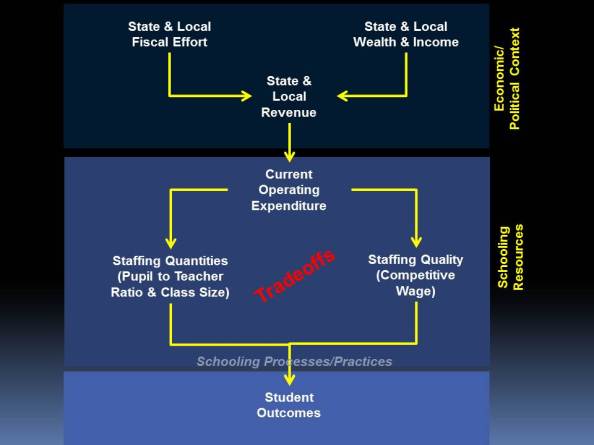Exploring Cross-State Variations in Resources, Outcomes and Gaps
For the past several years now, the Education Law Center of New Jersey and I have been producing a roughly annual report on the state of school finance systems. As that report has evolved, we have taken advantage of publicly available data to construct more and more indicators. Over the next several months, we will be releasing an update of the funding fairness report and a report in collaboration with Educational Testing Services which will explore in greater depth the relationships among the various indicators across states. I also expect in the near future to be releasing, with support of Shanker Institute, an update of my 2012 report exploring what we know about the relationship between school spending, schooling resources and student outcomes – in other words, the “does money matter” question.
In my last post, I explored national average trends in school spending and schooling resources, and discussed some of the recent literature on the topic. Here, I provide some snapshots of cross-state variations in financial effort, financial inputs, real resource inputs and student outcomes across states.
I begin with a relatively simple model of how effort and funding translates to resources, and how those resources ultimately provide the enabling conditions for the classroom conditions and practices that lead to better student outcomes. Despite the assertions of some, the schooling equation remains relatively simple – Schooling remains a human resource intensive endeavor, requiring competitive wages to recruit quality teachers and other school staff, and requiring sufficient capital outlay as well to provide the setting for schooling. The search for the holy grail of alternative technologies (broadly speaking, any substantive changes to educational organization/practices) that would substantially reduce the costs of achieving the same outcomes, has not, as of yet panned out. I have discussed this issue generally (as well as methods for studying it), and with specific reference to teacher compensation, as well as “chartering” [where the most aggressive technological substitutions in particular have been massive failures thus far].
REALLY SIMPLE MODEL
Building on the findings and justifications provided by Baker (2012 – Update coming soon!!!), we offer Figure 1 as a simple model of the relationship of schooling resources to children’s measurable school achievement outcomes. First, the fiscal capacity of states – their wealth and income – does affect their ability to finance public education systems. But, as we have shown in related research, on which we expand herein, the effort put forth in state and local tax policy plays an equal role (Baker, Farrie & Sciarra, 2010).
The amount of state and local revenue raised drives the majority of current spending of local public school districts, because federal aid constitutes such a relatively small share. Further, the amount of money a district is able spend on current operations determines the staffing ratios, class sizes and wages a local public school district is able to pay. Indeed, there are tradeoffs to be made between staffing ratios and wage levels. Finally, a sizable body of research illustrates the connection between staffing qualities and quantities and student outcomes (see Baker, 2012).
Figure 1
The connections laid out in this model seem rather obvious. How much you raise dictates how much you can spend. How much you spend in a labor intensive industry dictates how many individuals you can Exploring Cross-State Variations in Resources, Outcomes and Gaps | School Finance 101:

